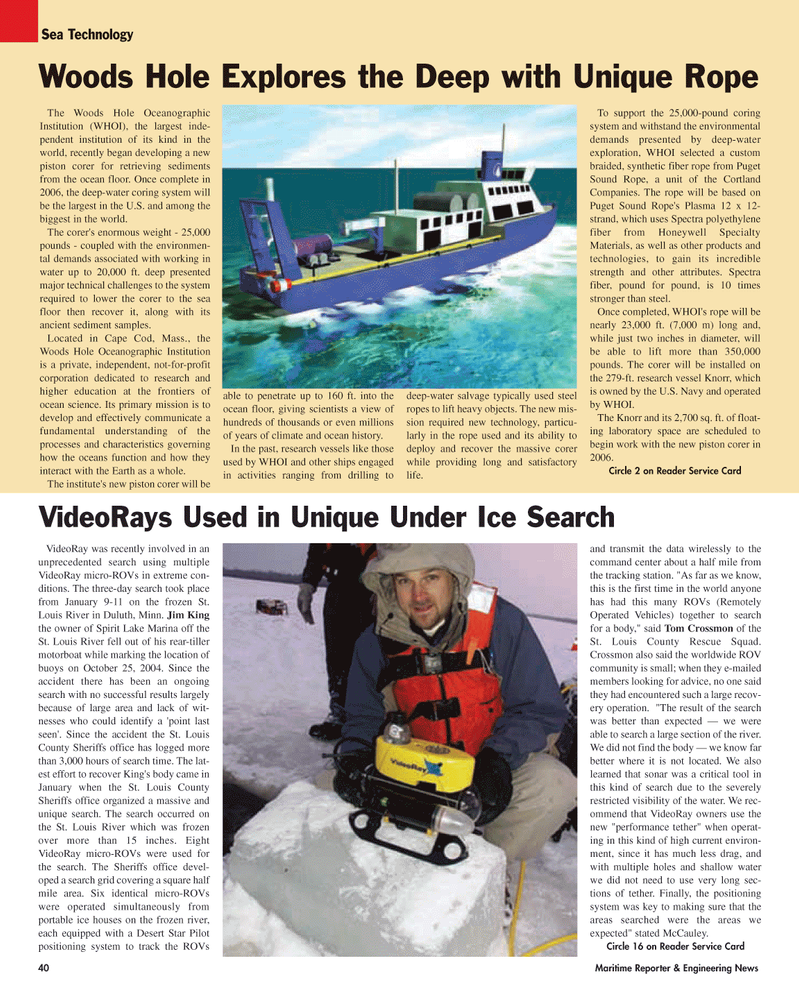
Page 40: of Maritime Reporter Magazine (March 2, 2005)
Read this page in Pdf, Flash or Html5 edition of March 2, 2005 Maritime Reporter Magazine
40 Maritime Reporter & Engineering News
The Woods Hole Oceanographic
Institution (WHOI), the largest inde- pendent institution of its kind in the world, recently began developing a new piston corer for retrieving sediments from the ocean floor. Once complete in 2006, the deep-water coring system will be the largest in the U.S. and among the biggest in the world.
The corer's enormous weight - 25,000 pounds - coupled with the environmen- tal demands associated with working in water up to 20,000 ft. deep presented major technical challenges to the system required to lower the corer to the sea floor then recover it, along with its ancient sediment samples.
Located in Cape Cod, Mass., the
Woods Hole Oceanographic Institution is a private, independent, not-for-profit corporation dedicated to research and higher education at the frontiers of ocean science. Its primary mission is to develop and effectively communicate a fundamental understanding of the processes and characteristics governing how the oceans function and how they interact with the Earth as a whole.
The institute's new piston corer will be able to penetrate up to 160 ft. into the ocean floor, giving scientists a view of hundreds of thousands or even millions of years of climate and ocean history.
In the past, research vessels like those used by WHOI and other ships engaged in activities ranging from drilling to deep-water salvage typically used steel ropes to lift heavy objects. The new mis- sion required new technology, particu- larly in the rope used and its ability to deploy and recover the massive corer while providing long and satisfactory life.
To support the 25,000-pound coring system and withstand the environmental demands presented by deep-water exploration, WHOI selected a custom braided, synthetic fiber rope from Puget
Sound Rope, a unit of the Cortland
Companies. The rope will be based on
Puget Sound Rope's Plasma 12 x 12- strand, which uses Spectra polyethylene fiber from Honeywell Specialty
Materials, as well as other products and technologies, to gain its incredible strength and other attributes. Spectra fiber, pound for pound, is 10 times stronger than steel.
Once completed, WHOI's rope will be nearly 23,000 ft. (7,000 m) long and, while just two inches in diameter, will be able to lift more than 350,000 pounds. The corer will be installed on the 279-ft. research vessel Knorr, which is owned by the U.S. Navy and operated by WHOI.
The Knorr and its 2,700 sq. ft. of float- ing laboratory space are scheduled to begin work with the new piston corer in 2006.
Circle 2 on Reader Service Card
Sea Technology
Woods Hole Explores the Deep with Unique Rope
VideoRay was recently involved in an unprecedented search using multiple
VideoRay micro-ROVs in extreme con- ditions. The three-day search took place from January 9-11 on the frozen St.
Louis River in Duluth, Minn. Jim King the owner of Spirit Lake Marina off the
St. Louis River fell out of his rear-tiller motorboat while marking the location of buoys on October 25, 2004. Since the accident there has been an ongoing search with no successful results largely because of large area and lack of wit- nesses who could identify a 'point last seen'. Since the accident the St. Louis
County Sheriffs office has logged more than 3,000 hours of search time. The lat- est effort to recover King's body came in
January when the St. Louis County
Sheriffs office organized a massive and unique search. The search occurred on the St. Louis River which was frozen over more than 15 inches. Eight
VideoRay micro-ROVs were used for the search. The Sheriffs office devel- oped a search grid covering a square half mile area. Six identical micro-ROVs were operated simultaneously from portable ice houses on the frozen river, each equipped with a Desert Star Pilot positioning system to track the ROVs and transmit the data wirelessly to the command center about a half mile from the tracking station. "As far as we know, this is the first time in the world anyone has had this many ROVs (Remotely
Operated Vehicles) together to search for a body," said Tom Crossmon of the
St. Louis County Rescue Squad.
Crossmon also said the worldwide ROV community is small; when they e-mailed members looking for advice, no one said they had encountered such a large recov- ery operation. "The result of the search was better than expected — we were able to search a large section of the river.
We did not find the body — we know far better where it is not located. We also learned that sonar was a critical tool in this kind of search due to the severely restricted visibility of the water. We rec- ommend that VideoRay owners use the new "performance tether" when operat- ing in this kind of high current environ- ment, since it has much less drag, and with multiple holes and shallow water we did not need to use very long sec- tions of tether. Finally, the positioning system was key to making sure that the areas searched were the areas we expected" stated McCauley.
Circle 16 on Reader Service Card
VideoRays Used in Unique Under Ice Search
MR MARCH 2005 #5 (33-40).qxd 3/1/2005 2:17 PM Page 8

 39
39

 41
41
